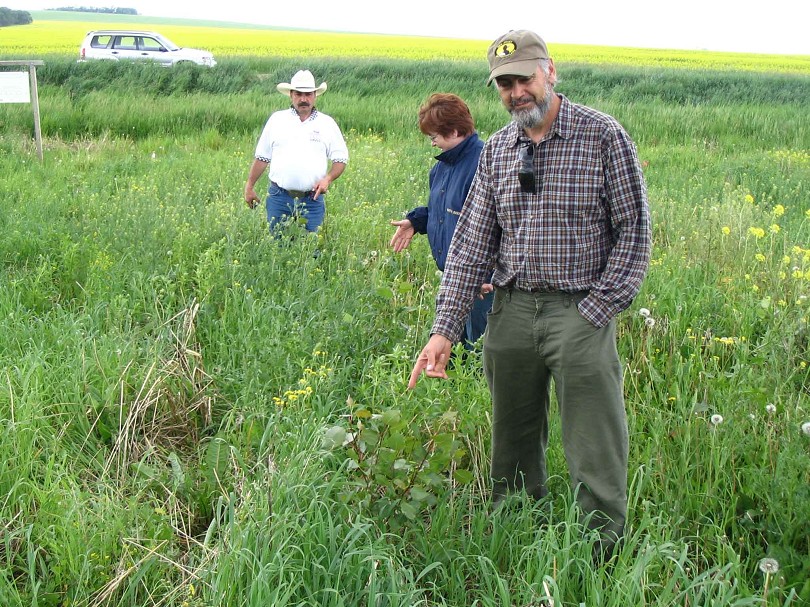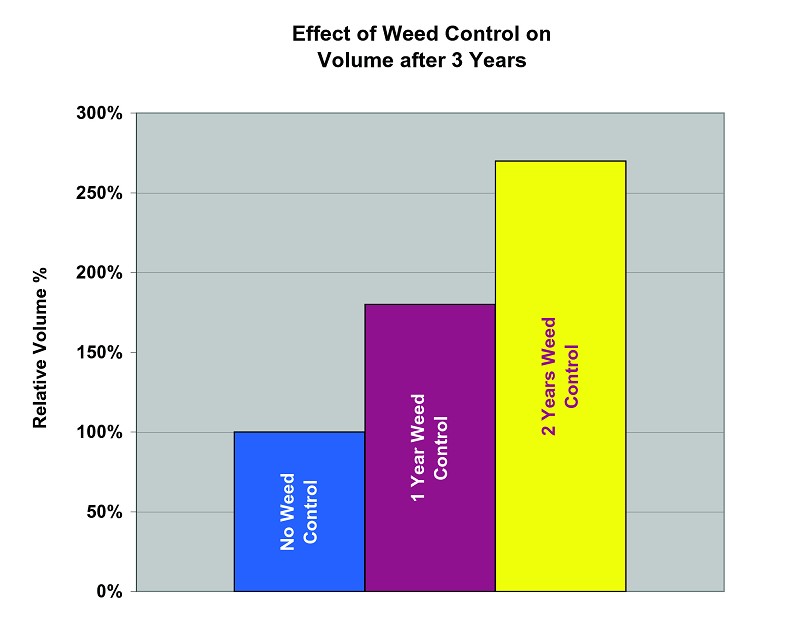by Michelle Sulz (Alberta-Pacific Forest Industries Inc.) and Cees van Oosten (SilviConsult Woody Crops Technology Inc.)
The best time to begin weed control is during site preparation before planting the poplar or willow crop. Growers have more weed control options before crop establishment than afterwards.
Weed control improves crop productivityPoplars and willows are shade intolerant. Weeds that overtop and shade the young trees can severely reduce their survival and early growth. For this reason, it is essential that weeds be controlled in new plantations. Poor survival and early growth - especially in the first two years - will have a very negative long-term impact on crop productivity because the canopy will fail to close and weeds will remain a problem for years to come. Many growers assume that, once the crop canopy is above the weeds, no further weed control is needed. However, even if tree survival is good, continued weed growth in older plantations will affect yield as weeds continuously compete for water and nutrients (see figure). Ongoing weed control is therefore needed until the crop canopy completely dominates the growing site.
Weed control protects the crop from other pestsWeeds provide habitat for damaging rodents (voles, pocket gophers) which seriously damage young trees girdling stems or by eating their roots. Voles prefer habitat with perennial grasses and lots of litter for cover. If weeds can be controlled from day one, rodent habitat is reduced and damage by rodents is largely prevented. |
A hybrid poplar crop near Birch Hills, SK. This site was prepared and planted in the spring of 2002. Because there was little weed control, it had to be replanted in 2003, and again in 2004. Poor site preparation led to an uncontrollable weed problem and doomed the crop from the start. Photo: Cees van Oosten |
|
|
Weed competition causes crop stress which can make the crop more susceptible to insect damage. If crop height and canopy closure are delayed by weeds, the period in which moose and deer can damage the crop by browsing is also extended, Dry conditions extend the need for weed control because of weed competition for moisture as well as the added risk of fire. In the Prairies, dry grasses, can represent a fire hazard. Noxious WeedsFarmers are obligated to control noxious weeds such as Canada thistle and scentless chamomile but there are few registered herbicides that can be used within the poplar or willow crop. For this reason, the most inexpensive and effective time to deal with noxious weeds is before planting - during site preparation. |
Classes of weeds and weed identification
Weeds are classified using definitions from ‘Weeds of the Prairies’[1]:
- Annual: A plant that germinates in the spring, sets seed in the same year and then dies.
- Winter annual: A plant that germinates in the fall and survives the winter as a dormant rosette. It resumes growth in the spring, sets seed in early summer and then dies.
- Biennial: A plant that germinates in the spring of the first year, producing a rosette that survives the winter in a dormant state. It resumes growth in the second year, flowers, sets seed and then dies.
- Simple perennial: A plant that survives for three or more seasons. Each spring the plant re-grows from stored root and crown reserves. Seed production may occur in the first season and in following years. Spread is mainly by seed.
- Creeping perennial: A plant that survives for three or more seasons. In addition to spreading by seed, these weeds also spread vegetatively through belowground rhizomes or aboveground stolons (runners).
The best timing and method of weed control depend on knowing the classes of weeds we are dealing with. For example, applying a herbicide to annual weeds in the early fall after they have gone to seed is ineffective, while spraying perennial weeds at that time can be very effective.
Creeping perennials are generally the most difficult weeds to control. These include such species as quackgrass, field bindweed morning glory and Canada thistle. Any plant that is not part of the crop is considered a weed. Volunteer barley, wheat, oats and canola in a poplar or willow crop are weeds and should be controlled.
Knowing the classification of weeds is a great first step, but knowing the species of some of the common problem weeds is important. Volunteer canola and wild mustard appear similar but the method of weed control may differ if the weed is a glyphosate-resistant canola. Books and the internet are both great resources for weed identification.
Scientific Names vs. Common Names
Common names can vary from region to region, so standard scientific names are preferable. Stinkweed, penny cress and Frenchweed are common names for the same species - Thlaspi arvense. The USDA Natural Resources Conservation Service ‘Plants Database’ should be used as an important reference.
Summary
There are a variety of reasons to control weeds and it is important that growers are well informed about the reasons for weed control and the types and species of common weeds so that the right decisions for the situation can be made.
-----------------------------




